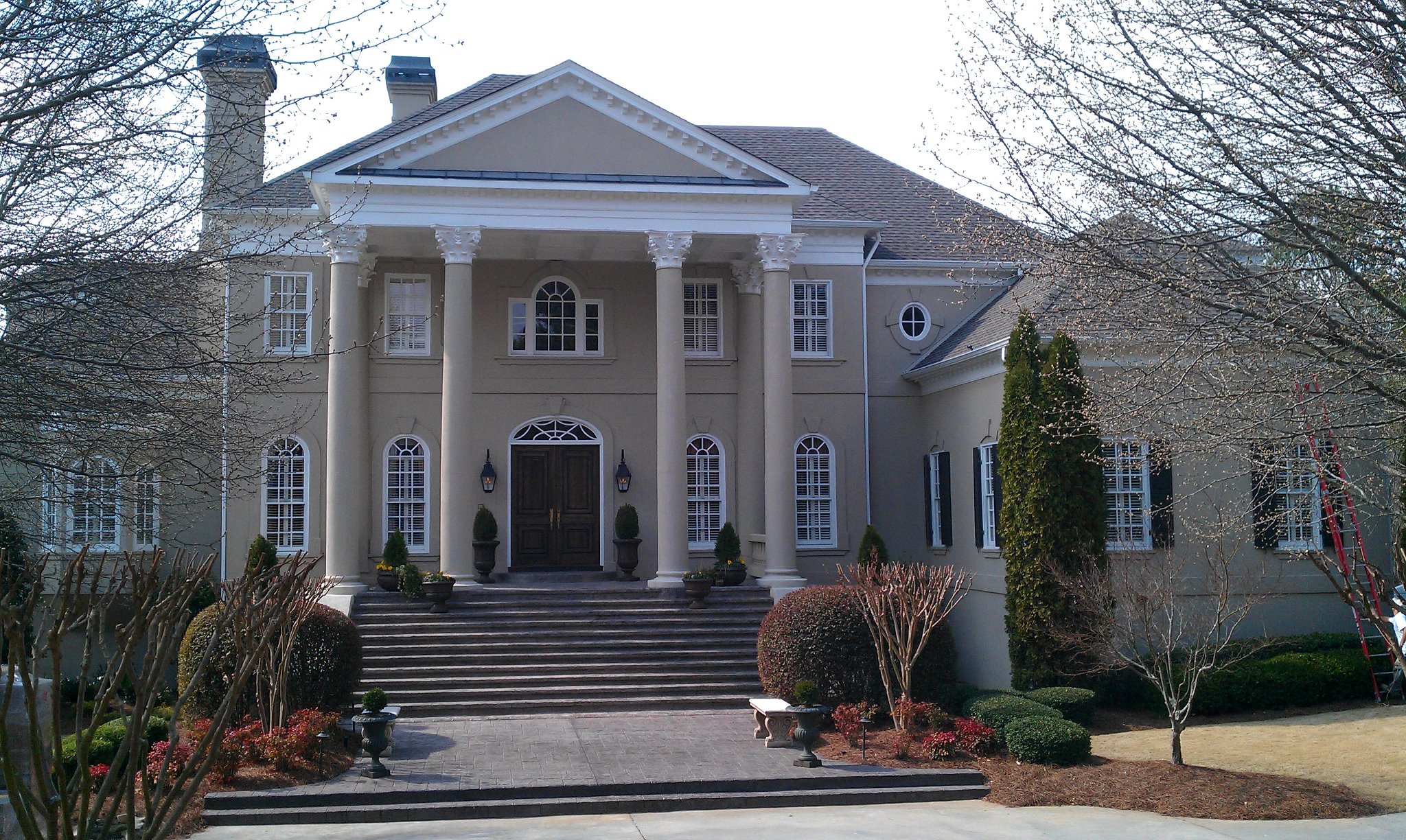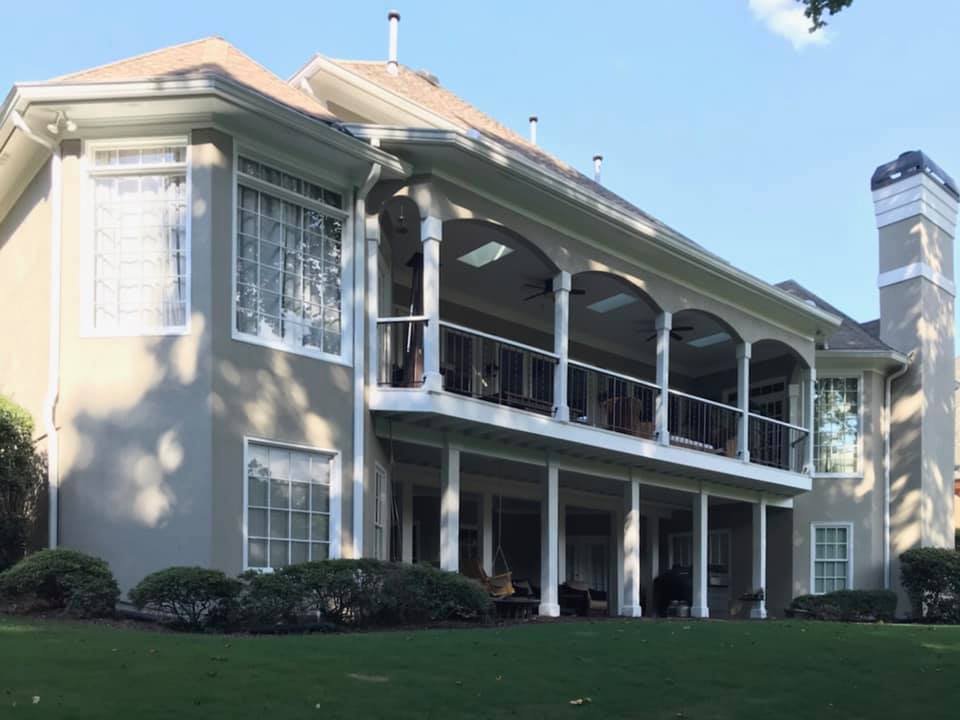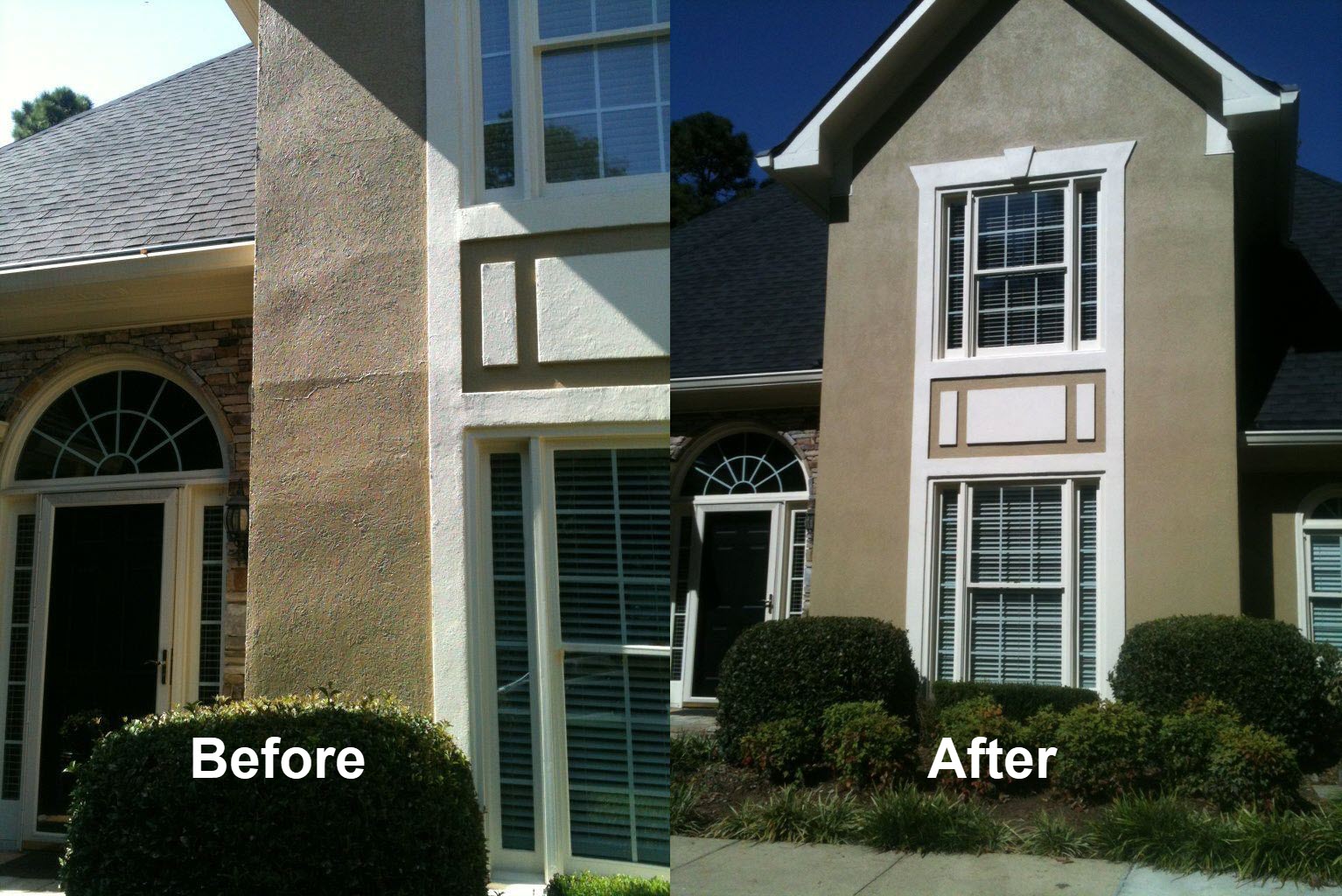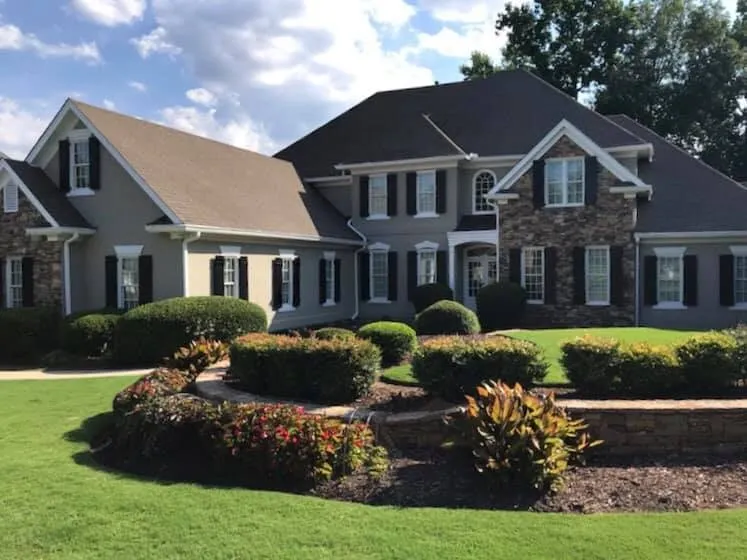Durable Fiber Cement Sidingin Vinings GA
Weather-Resistant Siding with a Natural Look
We Are Locally Owned & Operated For Over 24 Years
We Serve Businesses In And Around The Following Cities:
About Fiber Cement Siding Installations in Vinings, Georgia
Fiber Cement Siding Installation in Vinings Georgia
The Significance of Fiber Cement Siding
In the architectural landscape, siding plays a crucial role, extending beyond mere aesthetics to fortify the structural integrity of buildings. Particularly in Vinings, Georgia, a region notable for its charming mix of historical and modern residential architectures, siding options that deliver both durability and elegance are highly sought after. Among them, fiber cement siding emerges as a superior choice. Known for its robustness and versatility, fiber cement siding is fast becoming a preferred option for both residential and commercial properties in Vinings, offering a perfect blend of form and function. This material is not only celebrated for its strength and ability to withstand diverse weather conditions but also for its potential to mimic more premium siding options at a fraction of the cost.
For both new constructions and renovations, the choice of siding must balance functionality with aesthetics, a challenge that fiber cement siding meets commendably. Its potential for customization in color and style grants architects and builders ample creative latitude, enabling them to achieve designs that are both innovative and true to the area's architectural heritage. The rise in popularity of this siding option also intersects with an increasing demand for eco-friendly building materials. Homeowners and developers in Vinings are more frequently considering the environmental impact of their choices, and fiber cement offers an answer through its composition, which primarily includes sand, cement, and cellulose fibers.
Understanding the Installation Process
The process of installing fiber cement siding encompasses several meticulous steps that ensure both aesthetic appeal and structural resilience. Each phase of this installation, from preparation to final touches, is crucial to achieving a finish that is as durable as it is attractive. Advanced Stucco Repair, a trusted name in house siding solutions in Vinings, employs a detailed approach that combines precision with expertise, making them a top choice for homeowners and businesses alike seeking reliable siding options.
Installation begins with preparation, which involves inspecting the surface to ensure it is clean and ready for the new siding. The existing siding or wall is thoroughly examined for damages or areas that require repairs. This phase is critical because any underlying issues not addressed could compromise the new installation's integrity. Once the surface is prepared, professionals measure and cut the fiber cement boards to fit the building's dimensions. This requires careful precision since accurate measurements prevent gaps that could lead to water infiltration or aesthetic flaws.
Following this, the fiber cement boards are sealed, and flashing is installed. These steps create a watertight barrier, critical for protecting the underlying structures from moisture — a common issue in the humid climates of Georgia. The installation itself then proceeds methodically from the foundation wall upwards, with each board positioned to reinforce the building's water management system. Fasteners are used at specific intervals to secure the boards; choices here are significant, as they affect both the siding's adherence and its ability to handle temperature-induced expansion and contraction.
The final stages of installation involve applying caulking and paint or stain, as chosen, to protect joints and seams. This finishing touch not only provides additional weather resistance but also enhances the exterior's visual appeal, allowing property owners to achieve their desired aesthetic finish. Throughout the process, Advanced Stucco Repair provides careful oversight, ensuring all steps align with industry standards and local building regulations, delivering outcomes characterized by durability and beauty.
The Benefits of Fiber Cement Siding
When considering siding options for a home or commercial property, choosing the right material is paramount to ensure long-term satisfaction and value. Fiber cement siding offers abundant benefits, positioning itself as an outstanding choice for property owners seeking both durability and aesthetic versatility. One of the most significant advantages of fiber cement siding lies in its remarkable resilience. Unlike traditional wood or vinyl siding, fiber cement is not susceptible to rot, warping, or pest damage, offering a long-lasting solution that can withstand harsh weather conditions – an important consideration in Vinings, where seasonal variations can be quite pronounced.
The fire resistance of fiber cement siding further bolsters its appeal, contributing an added layer of safety to properties. This non-combustible material helps reduce fire risks, a particularly valuable quality for homes situated in wooded areas or regions prone to wildfires. In terms of maintenance, fiber cement siding demands significantly less attention than wood alternatives. A periodic wash and occasional repainting, typically after a decade or so, suffice to keep it looking fresh and new. Over the long term, this ease of maintenance translates into cost savings—both in terms of time and money—which is an attractive prospect for busy homeowners and commercial property managers.
Aesthetically, fiber cement siding offers a wealth of design possibilities. It can convincingly replicate the look of natural wood, providing an upscale appearance without the vulnerabilities. Additionally, it comes in a wide variety of pre-finished colors and textures, enabling property owners to choose a look that complements their architectural style and surroundings. In essence, using fiber cement siding allows for the preservation of design integrity across diverse architectural themes prevalent in Vinings, from modern minimalist to classic Georgian styles.
Advanced Stucco Repair harnesses these benefits to deliver exceptional installation services, ensuring property owners in Vinings enjoy the full spectrum of advantages offered by fiber cement siding. By combining high-quality materials with expert craftsmanship, they address the unique needs of each client, bringing their vision to life with siding that enhances both the beauty and function of their property.
Real-World Applications and Success Stories
The practical applications of fiber cement siding are as varied as they are impactful, with successful projects across residential and commercial sectors providing vivid testimony to its performance and adaptability. In the residential domain, numerous homeowners in Vinings have embraced this versatile siding solution to rejuvenate older homes that require modern updates while retaining historical charm. The adaptability of fiber cement to mimic wood, stucco, or even unique architectural finishes helps maintain the overall aesthetic coherence of a home while significantly enhancing its durability.
One notable project involved a historic home in Vinings that required a siding solution replicating traditional wood lap siding, a common feature in colonial homes. Advanced Stucco Repair utilized fiber cement siding to achieve the desired look without compromising on resilience. Homeowners were appreciative of how the updated exterior maintained the property’s character while alleviating their concerns about ongoing maintenance and weather-related damage.
Commercially, fiber cement siding offers properties a professional, high-end finish critical for businesses wanting to make a positive first impression. An example of this can be seen with a local Vinings retail store that underwent renovations to improve energy efficiency and enhance its exterior appeal. By choosing fiber cement siding, the business benefited from improved insulation and reduced heating and cooling costs while presenting a modern, inviting facade that attracted more foot traffic.
The flexibility of design combined with practical benefits such as increased fire resistance and excellent noise reduction capabilities make fiber cement siding particularly appealing for multifamily residential units and mixed-use developments. These qualities provide both a tangible return on investment for property developers and enhanced living experiences for occupants. Advanced Stucco Repair has been instrumental in helping clients navigate these projects, ensuring that both aesthetic goals and functional requirements are met seamlessly through their expert installation services.
Choosing the Right Installer
When it comes to maximizing the advantages of fiber cement siding, selecting the right installer is crucial. The expertise of the installation team directly influences the performance and longevity of the siding. In Vinings, Advanced Stucco Repair distinguishes itself through a deep commitment to quality and customer satisfaction. They bring years of experience and specialized knowledge to every project, ensuring precise execution from start to finish.
The benefits of working with seasoned professionals like Advanced Stucco Repair become particularly clear in complex installations involving integration with stucco, EIFS, or Dryvit. Fiber cement siding's versatility allows it to complement a range of exterior materials, enabling unique architectural designs while enhancing moisture control and insulation. An experienced installer is adept at creating harmonious transitions between materials, crucial for maintaining structural integrity and achieving a polished look.
Moreover, choosing a reputable installer comes with assurance against common pitfalls associated with improper installations, such as misaligned panels, inadequate fastening, or insufficient weatherproofing, all of which can compromise the siding's performance. Advanced Stucco Repair’s thorough approach includes a comprehensive review of the property, precise measurement and fitting, and adhering to the highest industry standards. This meticulous process ensures the final result not only meets but surpasses client expectations, adding lasting value to the property.
For homeowners and businesses in Vinings seeking reliable and aesthetically pleasing siding solutions, partnering with Advanced Stucco Repair guarantees an investment that will pay dividends both in visual appeal and protected longevity.
Subtle Recommendations and Customer Actions
In exploring fiber cement siding's compelling benefits and suitability for properties in Vinings, it becomes clear that finding a capable and experienced installer is paramount. Advanced Stucco Repair fits the bill, offering detailed, quality-focused service that meets both aesthetic desires and practical needs. Those considering new installations or upgrades can rest assured knowing they are selecting a material and partner that safeguards their investment while enhancing their property's charm and efficiency.
Through a comprehensive understanding of regional conditions and architectural styles, Advanced Stucco Repair positions itself as more than just an installer but as a guide for navigating choices to ensure each project reflects the client's vision and withstands the test of time. By choosing fiber cement siding installed by a skilled team, residents of Vinings can look forward to enhanced curb appeal and peace of mind regarding their property’s protection against the elements.
Given these insights, those looking to optimize the benefits of fiber cement siding should reach out to Advanced Stucco Repair to discuss their needs, ensuring a result that combines beauty, durability, and excellence at every turn.
Fiber Cement Siding Installations Gallery



Call Us Today to receive your Free Quote for
Fiber Cement Siding Installation in Vinings
Serving: Vinings, Georgia

About Vinings, Georgia
Early on, Vinings was known as Crossroads, and then Paces, after Hardy Pace, circa 1830. He operated Pace's Ferry across the Chattahoochee River, in this area between Atlanta, Buckhead, and Smyrna. Paces Ferry Road is still the main east–west road through Vinings. The Western and Atlantic Railroad laid rail tracks from Chattanooga, Tennessee to Atlanta in the 1840s. Vinings became a construction station for the railroad, and was inadvertently named for William H. Vining, as he worked on the railroad construction of "Vining's Bridge" laying tracks in the area. The railroad is still state-owned as it was from the beginning, and is now leased to CSX.
The Union Army occupied the Vinings area during Sherman's Atlanta Campaign of the American Civil War in 1864 and the subsequent March to the Sea. Pace's home, which had been used as a hospital for Union troops, was destroyed in the process. Vinings recovered after the war, as Governor Brown leased the railroad to Vinings to bring passengers to the springs and pavilions built to encourage a respite from the reconstruction of Atlanta. Vinings was officially recognized as a community in 1904, the same year the one-lane bridge was constructed across the Chattahoochee River. The town was never incorporated, though it had been discussed whether it should become a "township".
The Vinings Historic Preservation Society seeks to keep the town's history alive.
Vinings is located at 33°51′58.9″N 84°27′57.85″W / 33.866361°N 84.4660694°W. According to the United States Census Bureau, the CDP has a total area of 3.3 square miles (8.5 km), of which 3.2 square miles (8.3 km) is land and 0.1 square miles (0.26 km), or 3.34%, is water.
| Census | Pop. | Note | %± |
|---|---|---|---|
| 1990 | 7,417 | — | |
| 2000 | 9,677 | 30.5% | |
| 2010 | 9,734 | 0.6% | |
| 2020 | 12,581 | 29.2% | |
| U.S. Decennial Census 1850-1870 1870-1880 1890-1910 1920-1930 1940 1950 1960 1970 1980 1990 2000 2010 2020 | |||
Vinings was first listed as a CDP in the 1990 U.S. Census.
| Race / Ethnicity (NH = Non-Hispanic) | Pop 2000 | Pop 2010 | Pop 2020 | % 2000 | % 2010 | % 2020 |
|---|---|---|---|---|---|---|
| White alone (NH) | 7,805 | 5,913 | 6,459 | 80.66% | 60.75% | 51.34% |
| Black or African American alone (NH) | 1,155 | 2,679 | 4,049 | 11.94% | 27.52% | 32.18% |
| Native American or Alaska Native alone (NH) | 17 | 12 | 13 | 0.18% | 0.12% | 0.10% |
| Asian alone (NH) | 357 | 402 | 689 | 3.69% | 4.13% | 5.48% |
| Native Hawaiian or Pacific Islander alone (NH) | 2 | 6 | 3 | 0.02% | 0.06% | 0.02% |
| Other race alone (NH) | 15 | 38 | 62 | 0.16% | 0.39% | 0.49% |
| Mixed race or Multiracial (NH) | 107 | 182 | 476 | 1.11% | 1.87% | 3.78% |
| Hispanic or Latino (any race) | 219 | 502 | 830 | 2.26% | 5.16% | 6.60% |
| Total | 9,677 | 9,734 | 12,581 | 100.00% | 100.00% | 100.00% |
As of the census of 2000, there were 9,677 people, 5,227 households, and 1,740 families residing in the CDP. The population density was 3,039.2 inhabitants per square mile (1,173.4/km). There were 5,670 housing units at an average density of 1,780.8 per square mile (687.6/km). The racial makeup of the CDP was 81.97% White, 12.09% African American, 0.19% Native American, 3.69% Asian, 0.03% Pacific Islander, 0.83% from other races, and 1.21% from two or more races. Hispanic or Latino of any race were 2.26% of the population.
There were 5,227 households, out of which 11.5% had children under the age of 18 living with them, 26.3% were married couples living together, 5.2% had a female householder with no husband present, and 66.7% were non-families. 43.3% of all households were made up of individuals, and 2.4% had someone living alone who was 65 years of age or older. The average household size was 1.84 and the average family size was 2.61.
In the CDP, the population was spread out, with 10.8% under the age of 18, 15.5% from 18 to 24, 50.9% from 25 to 44, 16.6% from 45 to 64, and 6.1% who were 65 years of age or older. The median age was 30 years. For every 100 females, there were 92.5 males. For every 100 females age 18 and over, there were 91.8 males.
The median income for a household in the CDP was $88,876, and the median income for a family was $105,121. Males had a median income of $78,685 versus $46,315 for females. The per capita income for the CDP was $61,068. About 3.3% of families and 5.2% of the population were below the poverty line, including 4.1% of those under age 18 and 3.9% of those age 65 or over.
Vinings residents attend schools in the Cobb County School District. Residents are zoned to Teasley Elementary School, Campbell Middle School, and Campbell High School.
Vinings is unincorporated, and is therefore under the jurisdiction of Cobb's county commission and other public services. After the success of Sandy Springs, there was discussion and at least one public meeting on whether the town should also incorporate as a "city" (the only type of municipality in Georgia). With residents evenly split, there was no consensus, and the idea was shelved mainly due to concerns about potential property tax increases.
However, some expressed optimism that the Georgia Township Act might allow it to become a "township", equivalent in function to a village in many other U.S. states. This would allow it control of zoning and other land uses (the major dispute with the county), and as written would cap additional property taxes at a half mill (0.5 per mille, or 50¢ per $1000 annually). As of 2013, the bill has not been reintroduced in the Georgia General Assembly.
The proposed boundaries were Interstate 285 along the northwest side, Interstate 75 at the northeast end, the Chattahoochee River on the southeast side, and Atlanta Road (old US 41 until Cobb Parkway was built in the 1950s) at the southwest end.
